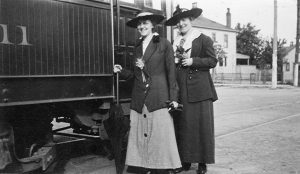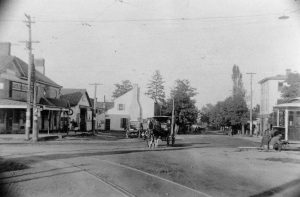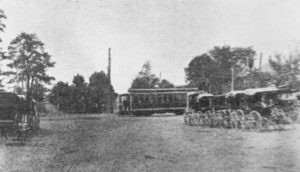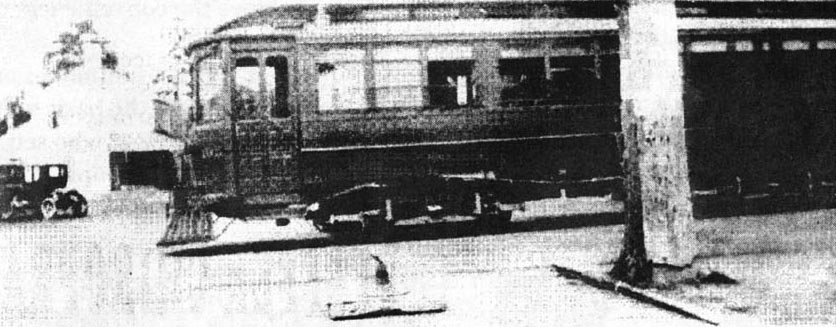A look back at Jeffersontown’s railway system
Writer / Beth Wilder, Director
Jeffersontown Historical Museum
 Throughout the first century of Jeffersontown’s existence, if one wished to go anywhere, it was typically by horse and wagon. Because of this, most people opted to live as near as possible to their place of business, which was fine, if one were a farmer or worked on the town square. For those who needed to find jobs further away from home – even a mile or two – the journey to get there and back was not without its hardship. For that matter, simply interacting with the larger city of Louisville took a good bit of time and was usually saved for a special family outing, to make the trip worth all the effort.
Throughout the first century of Jeffersontown’s existence, if one wished to go anywhere, it was typically by horse and wagon. Because of this, most people opted to live as near as possible to their place of business, which was fine, if one were a farmer or worked on the town square. For those who needed to find jobs further away from home – even a mile or two – the journey to get there and back was not without its hardship. For that matter, simply interacting with the larger city of Louisville took a good bit of time and was usually saved for a special family outing, to make the trip worth all the effort.
Louisville began using horse-drawn streetcars in 1859 and gradually switched to rail cars. In 1889, Louisville’s first electric streetcar opened, and by 1901 the city had completed electrification of all its lines. That worked quite well for local traffic, but it did not help insofar as connections to the rest of Jefferson County were concerned, so Louisville immediately began expanding what would be termed “interurban” service. The first line outside Louisville led to Crestwood. The second interurban line led to Jeffersontown.
In November 1902, directors of the Louisville Railway Company decided to end their policy of keeping close to the city limits and moved instead to expand their lines to the entire county. It was believed that if Louisville carried out its plans for the new interurban railway, no other car system in the United States would compare with the Louisville system. City leaders knew that hundreds of residents would prefer to live further out in the country if they had a reliable mode of transportation to get them to Louisville. They also realized the benefit such transport would be for gardeners, stockmen and dairymen, who could bring their wares to Louisville at least once a day, rather than once every week or two. It would also help with postal service, since many rural people did not receive their mail on a regular basis at that time.
The route to Jeffersontown began as an extension of the East Broadway line. It was designed to run through the lovely areas of the countryside and to avoid turn pikes and county roads. In this way, the interurban would naturally be placed directly along many of the farms that would supply goods to the area, and the owners of such property could give permission for the right-of-way, thus preventing any legal problems. It was also believed that passengers would be much happier with a country view, better time would be made and that there would be less danger of wrecks due to traffic on the roadways.
The Louisville Railway Company began at once to work on the Jeffersontown line, which they hoped would open within six months. In reality, it took a year and a half. Surveyors started work almost immediately, and the rights of ways were secured, but winter weather – as usual – slowed things down from the outset. Not to mention the fact that the land was a little bumpier and harder to deal with than they expected.
By mid-December 1902, six of the 13 miles to Jeffersontown along Taylorsville Road had already been built, but in June of 1903, a snag halted work. The interurban intended to cross the Southern Railroad tracks, which was more than dangerous to all parties concerned. At that time in history, the Southern Railway crossing at Taylorsville Road was atop a hill, and traffic passing through the town had to mount that hill and cross the railroad tracks. According to the June 1, 1903 edition of the Courier-Journal, “on account of the contour of the ground a view of only a short portion of the track can be obtained from the immediate approaches to the crossing.” Railroad officials wanted the electric line to be tunneled under their tracks, because they did not want to assume the constant liability of interurban cars crossing the tracks, and they felt the Louisville Railway Company should pay for it.
Of course, the Louisville Railway Company felt that Southern Railroad should pay for the tunnel underneath its tracks. Ultimately, it was decided that the expense of building a tunnel beneath the Southern Railroad tracks would be borne equally.
On April 29, 1904, at 2:30 p.m., a test run of the newly completed interurban line to Jeffersontown was made by several officials of the Louisville Railway Company. The running was smooth and easy, so on May 2, 1904, at 6:00 a.m., a new interurban car left Jeffersontown, while at the same time a car departed from Fifth and Jefferson in Louisville, the destination of each being the starting point of the other. From that moment on, cars would run regularly every hour until the new powerhouse, or sub-station, could be completed (the building now occupied by Schumann Antiques), allowing for a power boost and even more daily trips, if necessary.
 In the summer of 1905, an express service was created by the Louisville Railway Company to give county farmers and markets direct communication with one another. This express department was known as the Beargrass Railway Company. The express line originally ran once a day to and from Jeffersontown, but by 1910, it ran twice daily.
In the summer of 1905, an express service was created by the Louisville Railway Company to give county farmers and markets direct communication with one another. This express department was known as the Beargrass Railway Company. The express line originally ran once a day to and from Jeffersontown, but by 1910, it ran twice daily.
The Beargrass Railway had its own waiting room near the interurban “turn-around” on the town square, as well as an express agent, who oversaw loading and unloading the freight cars. So far as regular trips on the interurban were concerned, in 1903 the fare was intended to be less than one-third of the cost of train fare, which was 42 cents. Even so, a 1909 Jeffersonian article mentioned the great need for a reduction in the interurban passenger rates. At that time, passengers were begging to have a 25-cent rate for a round trip, but to no avail.
Accidents were not unknown to happen around the interurbans, and safety campaigns were created to provide instructions to the riding public, such as “Wait until the car stops,” “Allow passengers to get off car before you try to get on,” “Always face forward in either getting on or off car,” and “Don’t forget to pay your fare.”
By and large, the interurban was a major benefit to people of the county, but at times, it did have its drawbacks as well. Snow would often prevent the cars from being able to run on the tracks, and heavy rainstorms could also keep cars from going any further.
Still, the interurban was the preferred mode of transportation to and from Louisville and surrounding areas for years, until cars became more affordable and the number of interurban passengers began to decline. The line was shut down in 1932, and the Blue Motor Coach bus line replaced the interurban as an alternative means of transportation.
The interurban, however, can be credited with a great upsurge in business and growth in Jeffersontown during the early 1900s. Although no traces of the old tracks remain in Jeffersontown, glimpses of them can still be seen in early photos of the town, before Taylorsville Road became a paved thoroughfare. Thanks to the interurban, the route that connected Jeffersontown to Louisville became lined with subdivisions and businesses that brought Jeffersontown into the 20th Century.






